Why Your Tankless Water Heater Stops Working (And What to Do About It)
Tankless water heater troubleshooting begins with understanding that these units heat water on demand. When problems occur, they typically fall into a few common categories that you can often fix yourself.
Quick Troubleshooting Checklist:
- No hot water - Check power supply, gas valve, and circuit breakers
- Water too hot or cold - Verify thermostat settings and flow rate
- Low water pressure - Clean aerators and inlet screen filters
- Unit won't ignite - Inspect gas supply, flame sensor, and igniter
- Error codes showing - Consult your manual for specific code meanings
- Leaking water - Tighten connections and check pressure relief valve
- Strange noises - Flush system to remove mineral buildup
Tankless water heaters are efficient and long-lasting, with a lifespan of up to 20 years compared to 10-15 years for traditional tanks. They can save 27 to 50 percent of fuel costs by only heating water when you need it. While many common issues have simple solutions, this guide will help you determine what's happening inside your unit and when it's time to call a professional.
How a tankless water heater works: When you turn on a hot water tap, cold water flows into the unit. A sensor detects the flow and activates a gas burner or electric element. The water passes through a heat exchanger and comes out hot at your faucet in seconds.
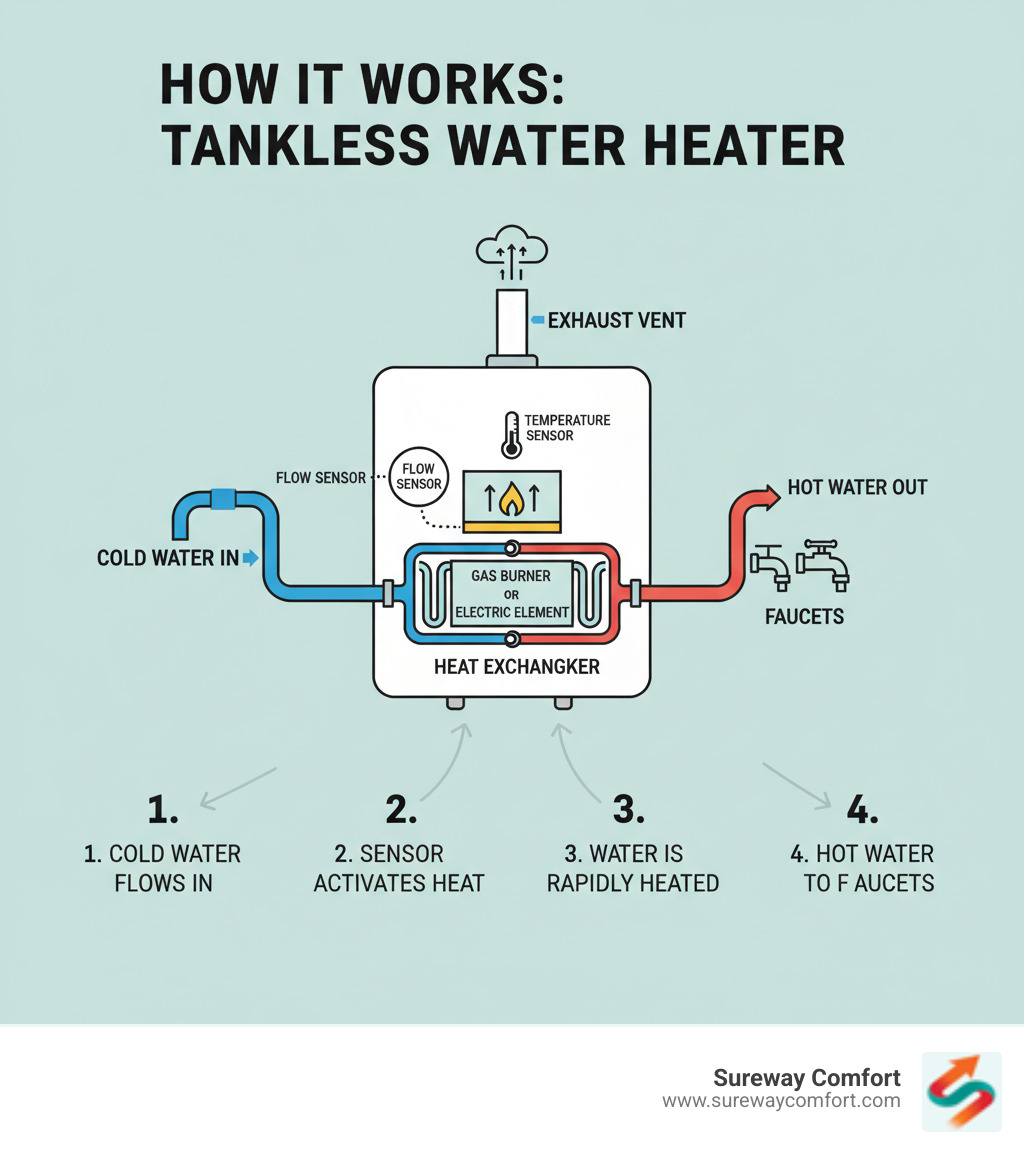
If you're experiencing issues beyond basic troubleshooting in the Bridgeville area, contact Sureway Comfort for expert assistance.
Initial Checks & Simple Resets: Your First Line of Defense
Before worrying about expensive repairs, tackle the basics. Many tankless water heater troubleshooting problems can be solved with simple checks that take just a few minutes and might save you a service call.
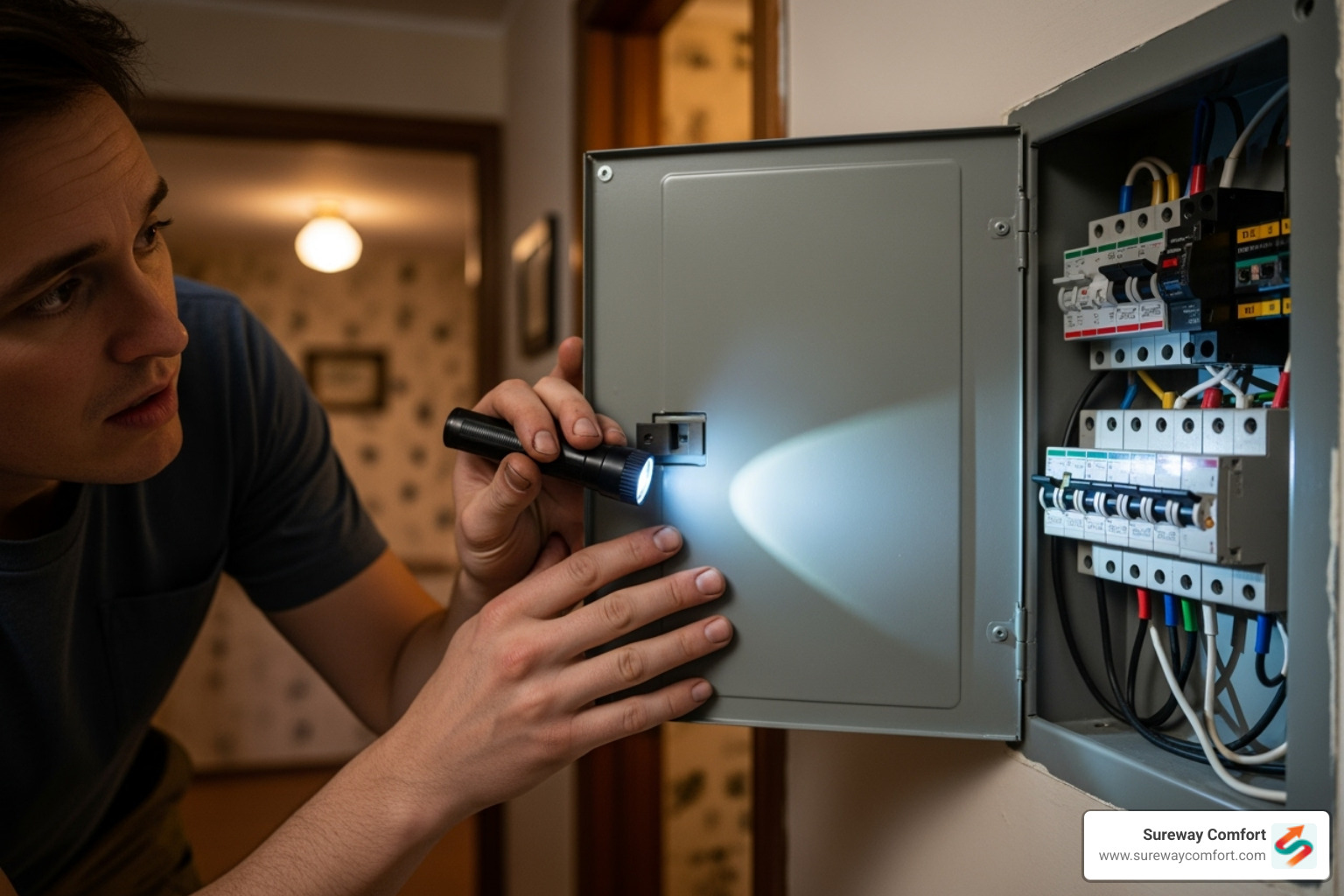
Checking Power and Fuel Supply
If your hot water stops working, the cause might be simple. Your tankless heater needs power and fuel to operate.
For electric units, check your electrical panel for tripped circuit breakers. A breaker can look like it's on when it's not, so flip it all the way off, then back on. Also, ensure the unit is securely plugged in.
For gas units, confirm the gas supply valve to the heater is fully open (parallel to the pipe). If you have a propane tank, check that it isn't empty. For natural gas, ensure there are no service interruptions. If your unit has a pilot light, verify it's lit. Check the gas line for any kinks restricting flow.
How to Reset Your Tankless Water Heater
Sometimes your tankless water heater just needs a reset to clear minor electronic glitches. Here's how to power cycle your unit properly:
- Turn off the power supply. For electric models, flip the circuit breaker off or unplug the unit. For gas models, turn off the gas supply valve first, then switch off the electrical power.
- Wait 5 to 10 minutes. This allows the system to fully reset.
- Restore power. Turn everything back on in reverse order. For gas units, restore electrical power first, then open the gas valve.
Always check your owner's manual for model-specific reset instructions.
Understanding Your Unit's Display: Common Error Codes
Your tankless water heater's digital display uses error codes to tell you what's wrong.
- Ignition failure codes (e.g., '11', 'E003') mean the unit tried to ignite but failed. This could be a gas supply issue, a dirty flame sensor, or a problem with the igniter.
- Flow rate errors indicate not enough water is moving through the system to trigger heating. This can happen with a low-flow fixture or a clogged inlet filter.
- Venting errors signal problems with air supply or exhaust, such as a blocked vent.
Your owner's manual will have a list of codes and their meanings. You can also check Rheem's comprehensive troubleshooting guide for a detailed list. Some codes can be cleared with simple fixes, while others require a professional.
If you see persistent error codes after basic tankless water heater troubleshooting, contact Sureway Comfort for expert help.
Common Tankless Water Heater Problems & DIY Solutions
When your tankless water heater acts up, you don't always need to call a professional. Many common issues have straightforward fixes you can handle with basic tools and a little know-how.
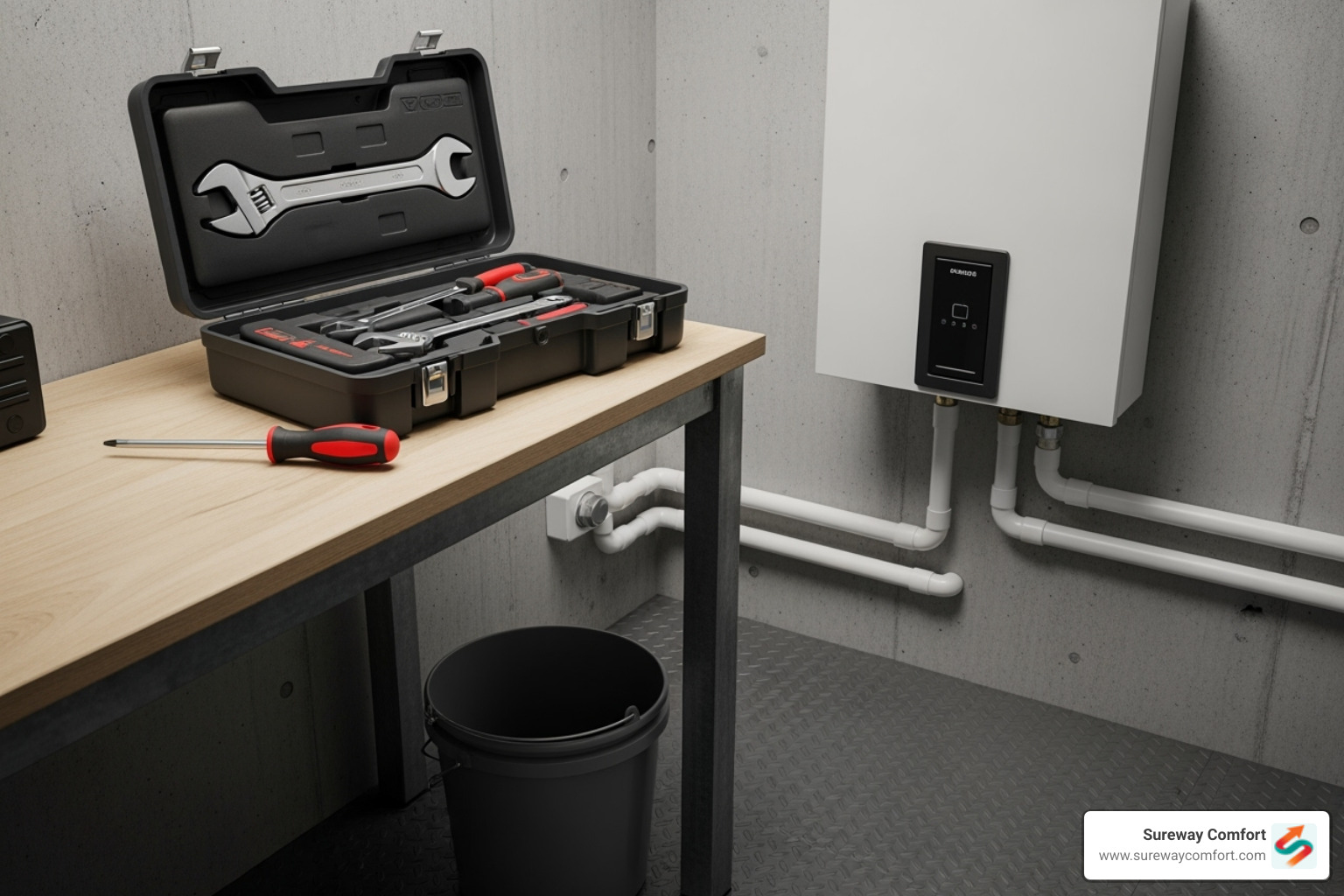
No Hot Water or Inconsistent Temperatures
Temperature problems are a common complaint but are often easy to fix.
- System Overload: Your heater has a maximum output (gallons per minute, or GPM). If you run a shower, dishwasher, and washing machine at once, you may exceed its capacity, causing the water to turn lukewarm. Try staggering your hot water use. If this is a constant issue, you may need a higher-capacity unit.
- 'Cold Water Sandwich' Effect: This is the burst of cold water mid-shower. It's not a malfunction, but rather cold water trapped in the pipes between uses being pushed out first. Learn more about tankless water heater temperature fluctuation.
- Flow Rate & Thermostat: Most units need a minimum flow (e.g., 0.5 GPM) to activate. If you only crack open a faucet, the heater may not turn on. Also, check that your thermostat is set correctly, typically around 120°F (49°C).
A Guide to DIY Tankless Water Heater Troubleshooting for Low Water Pressure
Low hot water pressure is often caused by simple blockages.
- Check Faucet Aerators: These small screens on your faucets catch debris. Unscrew them, rinse them clean, and screw them back on.
- Clean the Inlet Screen Filter: This filter on the cold water intake protects the unit from sediment. Turn off the water supply, then remove and rinse the filter according to your owner's manual.
If pressure is low throughout the house, the problem may be with your main water line or pressure regulator, which requires professional diagnosis.
Ignition and Flame Failure Troubleshooting
If your heater won't light or stay lit, it's often related to the gas supply or a dirty sensor.
- Check Gas Supply: Ensure your gas valve is fully open and your propane tank isn't empty. Gas pressure issues require a professional.
- Clean the Flame Sensor and Igniter: A dirty flame sensor can't detect the flame and shuts off the gas as a safety measure. A dirty igniter won't spark properly. After turning off power and gas, you can gently clean these components with fine steel wool or an abrasive pad.
- Check Air Supply: The unit needs fresh air for combustion. Check that air intake and exhaust vents are clear of debris, nests, or other obstructions. Blocked vents are a common reason a heater won't stay lit.
What to Do If Your Tankless Water Heater is Leaking or Making Noise
Leaks and strange noises are signals you shouldn't ignore.
- Leaks: If you spot a leak, immediately shut off the water supply and power/gas to the unit. Minor drips from pipe fittings can often be fixed by tightening the connection with a wrench. If the pressure relief valve is dripping or you see a major leak, it's time to contact Sureway Comfort.
- Noises: Banging or gurgling sounds are usually caused by mineral buildup (scale) in the heat exchanger. Flushing the system typically solves this. Rattling may just be loose mounting brackets that need tightening. For more, see our guide to tankless water heater noises and solutions.
Essential Maintenance for Preventing Future Issues
Regular maintenance keeps your tankless water heater running reliably for its full 20-year lifespan. A little attention now can save you from expensive repairs and cold showers later.
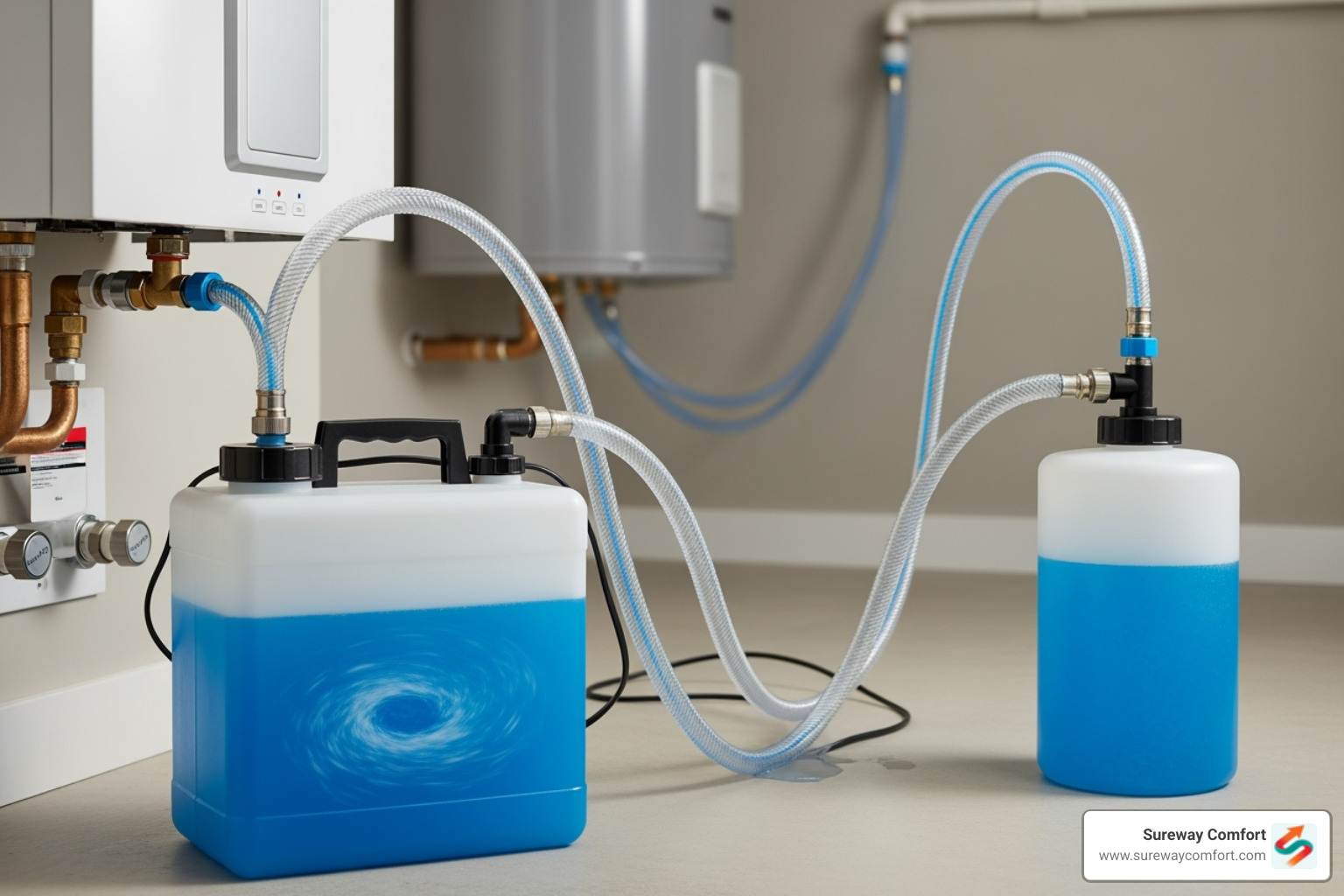
The Importance of Descaling: Fixing and Preventing Mineral Buildup
Mineral buildup (scale) is the number one enemy of tankless water heaters, especially in areas with hard water. Scale forces your unit to work harder, reducing efficiency and leading to damage. Signs of scale include reduced water flow, inconsistent temperatures, and banging or kettling sounds.
The solution is to flush your system with a descaling solution (like white vinegar) to dissolve the minerals. This should be done every six months to a year, depending on your water hardness. You can use a descaling kit and follow the instructions in your owner's manual. For a long-term solution, consider a whole-home water softener.
Clearing Air Supply and Exhaust Blockages
Gas tankless heaters need to breathe. Regularly check that your intake and exhaust vents are clear of bird nests, leaves, or other debris. Ensure there is proper clearance around the unit for airflow. Blocked vents can cause the unit to shut down and are a safety hazard. If you notice soot buildup or a yellow flame instead of a blue one, this indicates a combustion problem that requires immediate professional service. For more details, see our Tankless Water Heater Venting Guide.
How Often Should You Service Your Tankless Water Heater?
We recommend annual professional service for your tankless water heater, even if it seems to be working fine. A technician will perform a thorough inspection, clean critical components, check gas pressure, and catch potential issues early. This is the best way to ensure safety, efficiency, and keep your Tankless Water Heater Warranty valid. Between professional visits, continue to clean your inlet and air filters and watch for any changes in performance.
If it's been over a year since your last service in the Bethel Park or Bridgeville area, contact Sureway Comfort to schedule a maintenance check.
How to Winterize a Tankless Water Heater
If you live where temperatures freeze, you must winterize your unit to prevent the heat exchanger from cracking. While most units have built-in freeze protection, it may not be enough during extreme cold or power outages.
The best protection is to drain the unit completely:
- Turn off the water, power, and gas supplies.
- Open a hot water faucet to relieve pressure.
- Open the drain valves on the unit and let all water flow out.
- Insulate any exposed pipes leading to and from the heater.
Leave the power disconnected until you are ready to use the heater again. Always follow your manufacturer's specific winterization guidelines.
Understanding Your System & When to Call a Professional
You can handle many common tankless water heater troubleshooting issues yourself, but it's crucial to know when to step back and call an expert for safety and to prevent further damage.
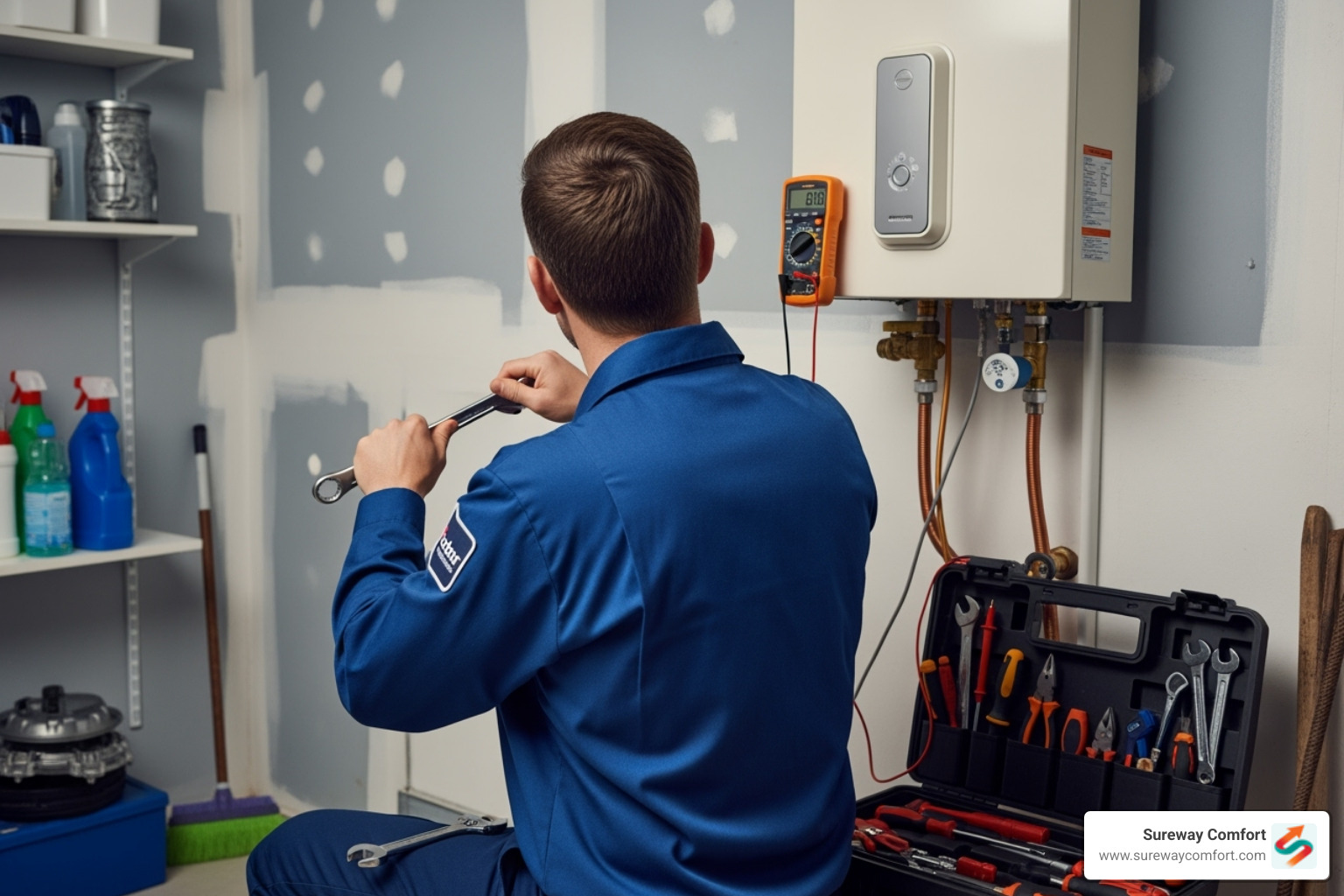
Gas vs. Electric: Key Differences in Operation and Repair
Knowing your system type helps with troubleshooting. Gas-fired units are powerful, delivering 2-5 GPM, making them ideal for whole-home use. They require a gas line and proper venting. Troubleshooting often involves the gas supply, igniter, or vents. The benefits of gas water heaters include higher output for larger households.
Electric tankless heaters are simpler and more compact, making them great for point-of-use applications (like under a sink) or smaller homes. They don't require venting. Troubleshooting usually deals with electrical supply, heating elements, or flow sensors.
When DIY Isn't Enough: Signs You Need Professional Tankless Water Heater Repair
Some situations are too risky or complex for DIY repair. Call a professional if you notice any of the following:
- Smell of Gas: This is an emergency. If you smell rotten eggs, turn off your gas supply if it's safe to do so, evacuate your home, and call your gas company from outside.
- Significant Water Leaks: While you can tighten a dripping fitting, a large leak or one coming from inside the unit requires a pro. Shut off the water and power, then contact us.
- Persistent Error Codes: If an error code returns after you've tried basic fixes, it's time to call for diagnostics.
- Electrical Problems: Repeatedly tripped breakers, a burning smell, or visible damage to wiring are serious hazards that require a qualified technician.
- Discolored Water: Rusty, cloudy, or greenish water can indicate internal corrosion or contamination that needs professional assessment.
- You Feel Unsafe: Trust your instincts. If a repair feels beyond your skill level or comfort zone, stop and call a professional. It's the smartest and safest decision.
For a complete list of warning signs, read our guide on signs you need tankless water heater repair.
Frequently Asked Questions about Tankless Water Heater Troubleshooting
When we're working with homeowners on tankless water heater troubleshooting, we tend to hear the same questions come up again and again. These are real concerns from people just like you who are trying to understand their system better and get their hot water flowing smoothly again. Let's address the most common ones.
What causes the 'cold water sandwich' effect?
Have you ever stepped into what should be a hot shower, only to get hit with a sudden blast of cold water a minute or two in? That's the notorious 'cold water sandwich' effect, and we get asked about it all the time. Here's the thing: it's not actually a problem with your tankless water heater. Your unit is working exactly as it should.
What's happening is this—when you turn off the hot water after your first use, there's still cold water sitting in the pipes between your tankless heater and your faucet or showerhead. When someone turns on the hot water again shortly after, that trapped cold water gets pushed through the pipes first, creating that unpleasant cold burst before the newly heated water arrives. Think of it as the leftover water in your plumbing system, not a heater malfunction. It's more noticeable with back-to-back hot water uses, like when you're washing dishes and then immediately hop in the shower.
How do I know if my tankless water heater is overloaded?
Your tankless water heater is trying to tell you it's overloaded when the water temperature drops from hot to lukewarm or even cold while you're using multiple hot water sources at the same time. Picture this scenario: someone's taking a shower, and then the washing machine kicks on, or maybe the dishwasher starts its cycle. Suddenly, the shower water isn't nearly as hot anymore. That's your unit saying, "I can only heat so much water per minute!"
Every tankless water heater has a maximum flow rate, measured in gallons per minute (GPM). When your combined hot water demand from all running fixtures exceeds that capacity, the unit simply can't keep up. It's like trying to fill three buckets at once from a single faucet—the flow to each bucket slows down. If this happens frequently in your home, you might need a higher-capacity unit, or you may need to stagger your hot water usage throughout the day.
What should I do first if my tankless water heater is leaking?
A leaking tankless water heater needs immediate attention, and we're glad you're asking this question because acting quickly can prevent serious water damage to your home. Your first two steps should always be shutting off the water supply and cutting the power or gas to the unit—in that order.
Find the cold water shut-off valve that feeds your tankless heater and turn it completely off. This stops more water from entering the system and making the leak worse. Next, turn off the power supply. For electric units, flip the dedicated circuit breaker to the off position. For gas units, close the gas supply valve and then switch off the electrical power to the unit as well.
Once you've made everything safe, you can take a closer look. Sometimes it's just a loose connection that needs tightening with a wrench—an easy fix. But if you see water pooling from inside the unit, or if the leak seems significant and you can't pinpoint where it's coming from, that's your cue to contact us right away. Water leaks can indicate anything from a faulty pressure relief valve to internal corrosion, and those issues require professional assessment and repair. Don't wait on this one—water damage only gets worse with time.
Get Your Hot Water Flowing Again
This guide to tankless water heater troubleshooting should give you the confidence to handle many common issues, from a simple reset to cleaning a filter. Regular maintenance, like flushing your system annually, is the best way to prevent problems and ensure your unit lasts its full 20-year lifespan.
However, safety always comes first. If you smell gas, see a major leak, face electrical problems, or feel uncertain about a repair, stop immediately and call a professional. Knowing your limits is the smartest troubleshooting decision you can make.
Some jobs simply require an expert. At Sureway Comfort, our experienced technicians understand these systems inside and out. We have the right tools and expertise to diagnose and fix any issue, from stubborn error codes to internal component failures.
If you need a new unit, we provide professional tankless water heater installation services to ensure it's done right from the start. For persistent issues or professional maintenance in the Bethel Park area, we're here to help.
Contact us today for expert tankless water heater services! Let's get your hot water flowing again.



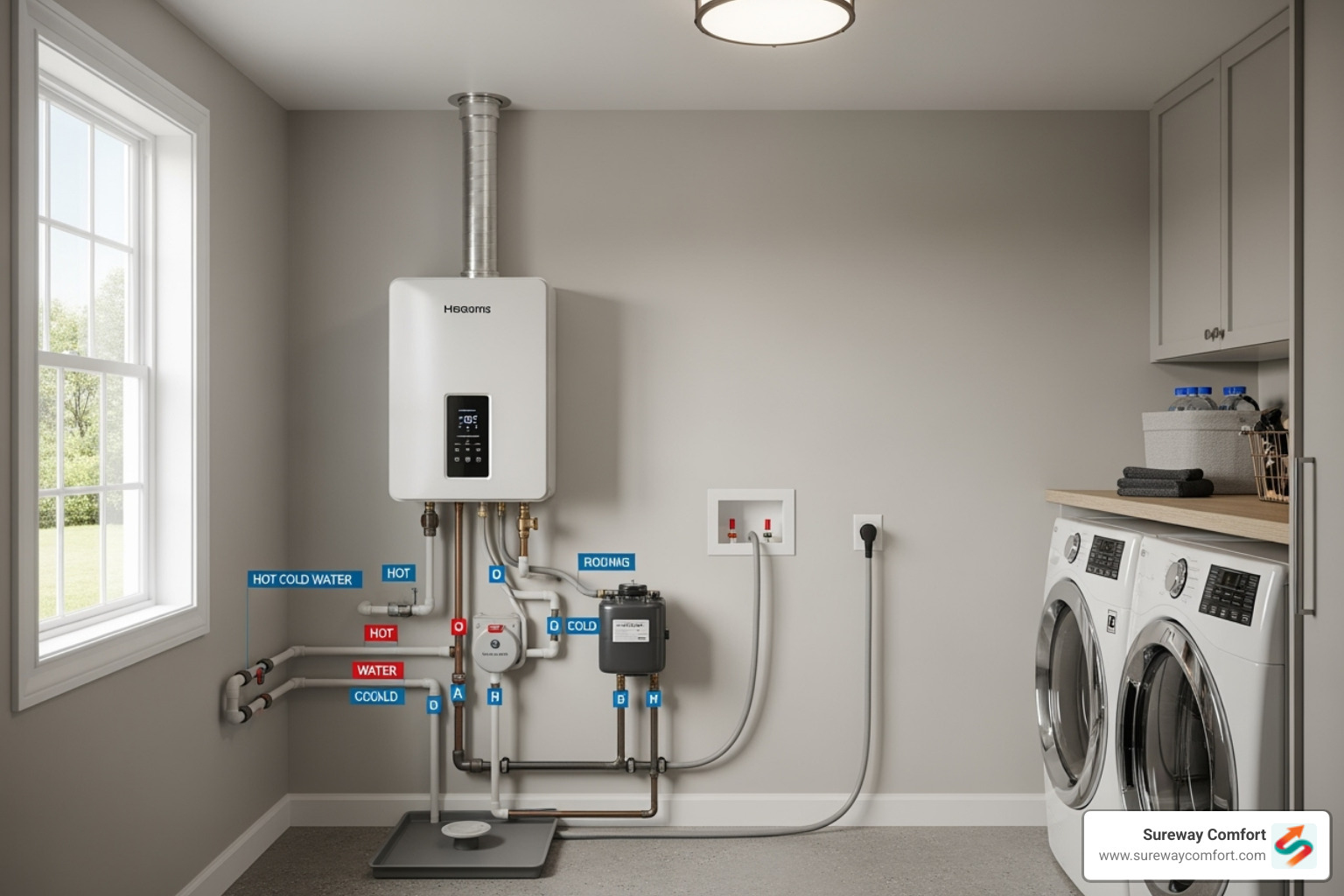


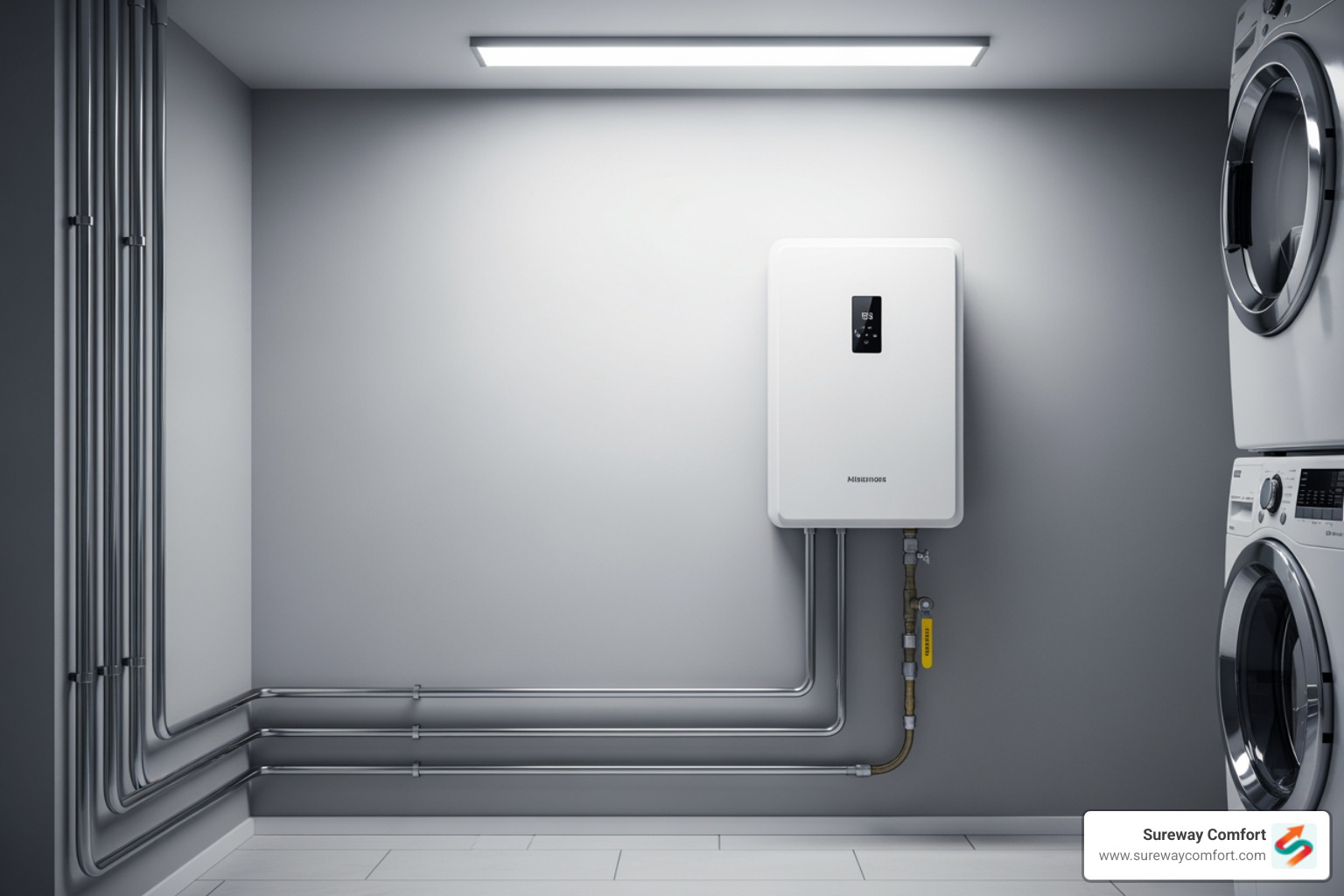
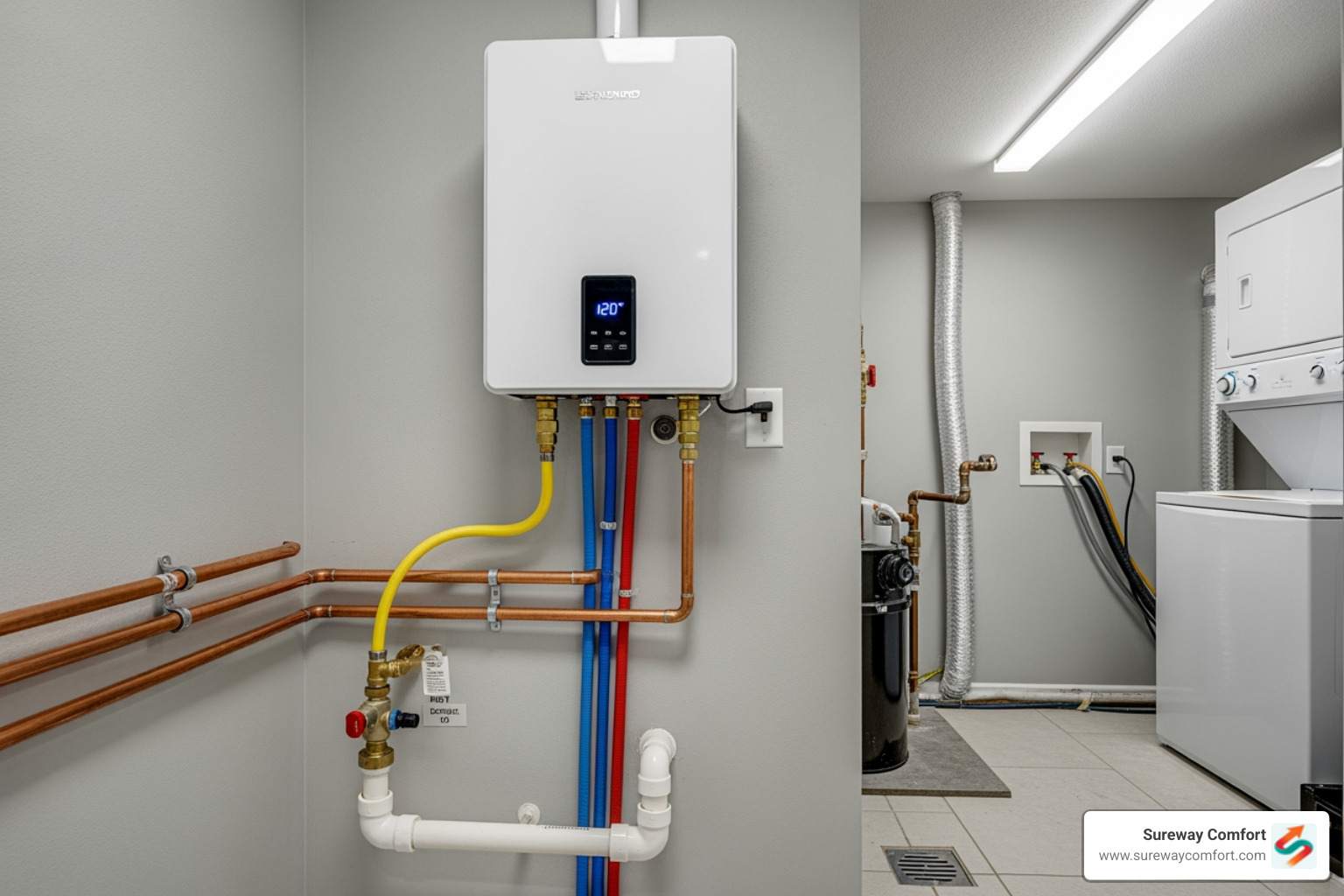




















.avif)



